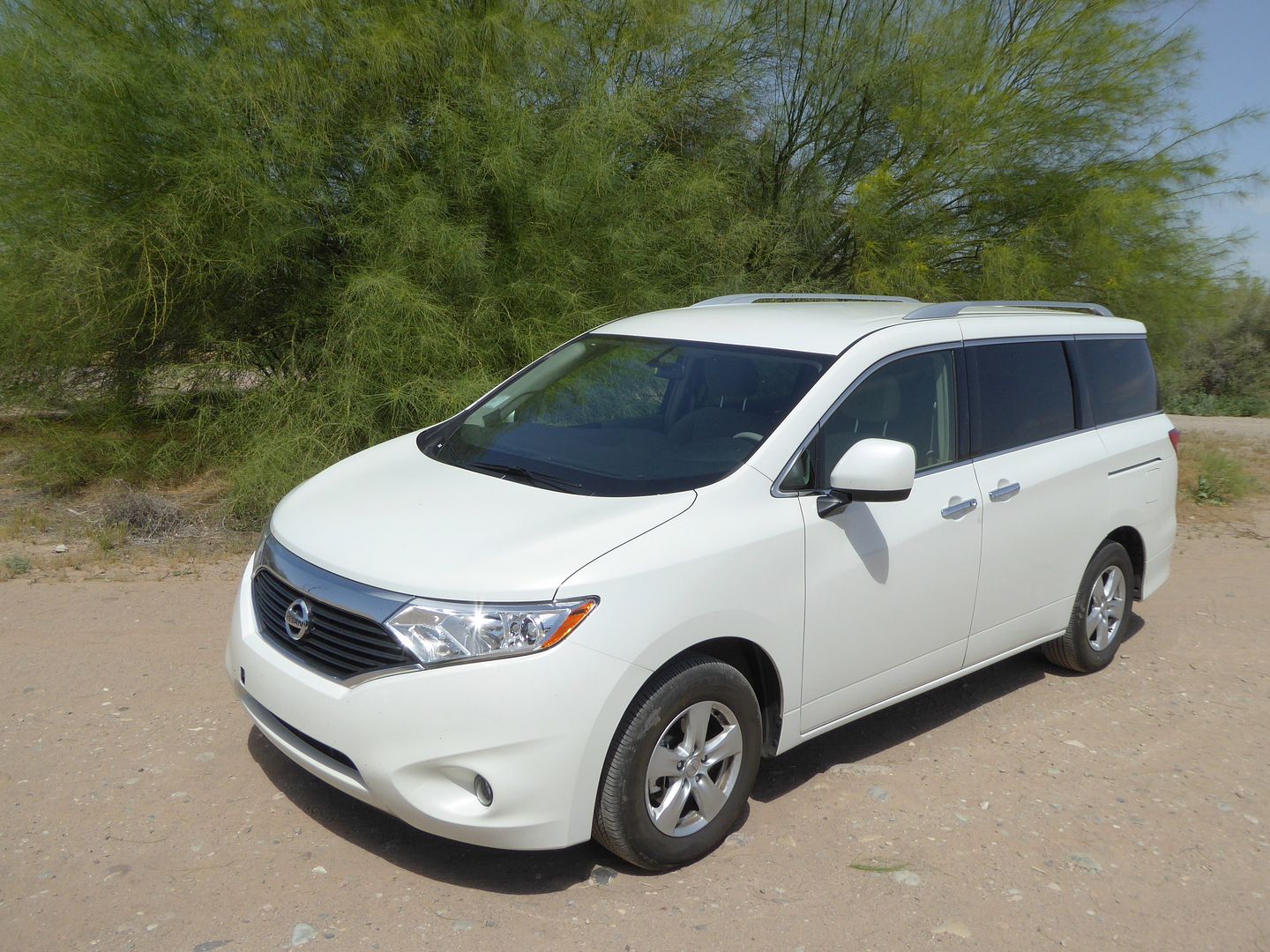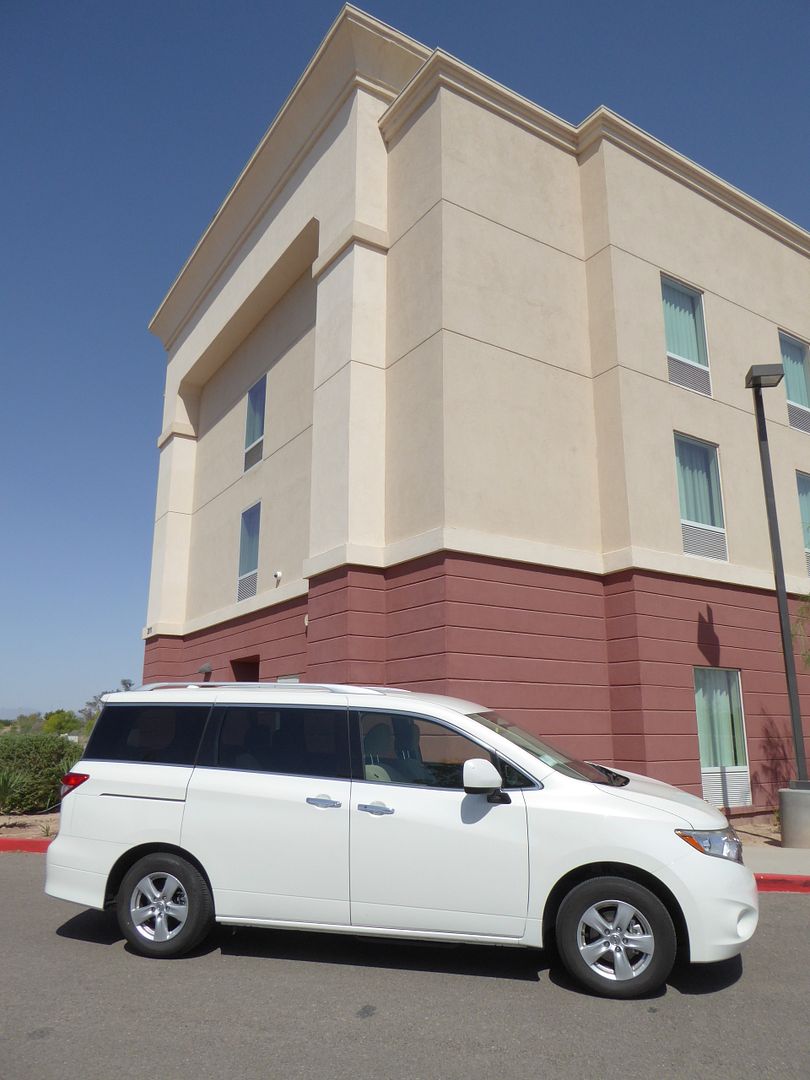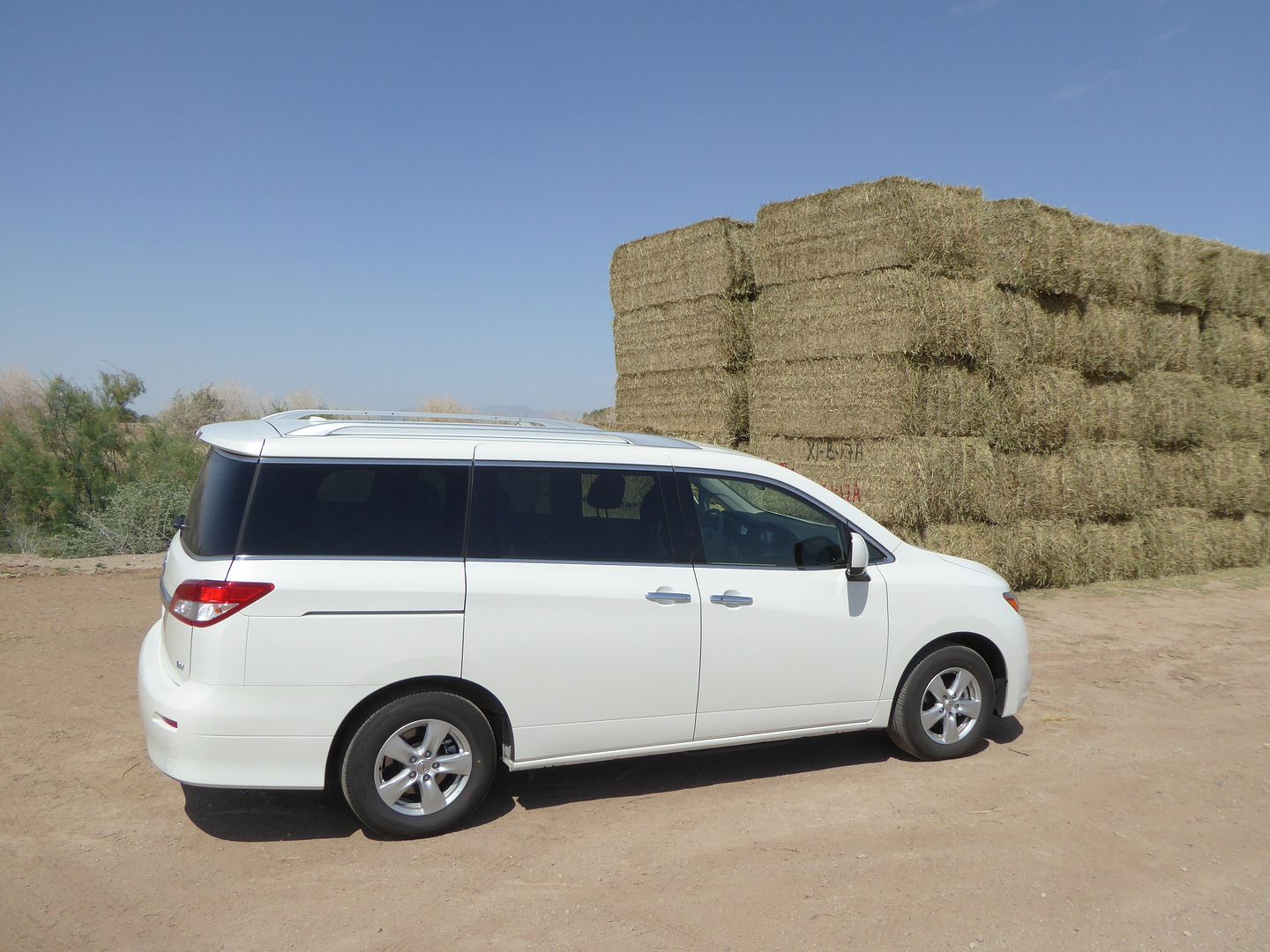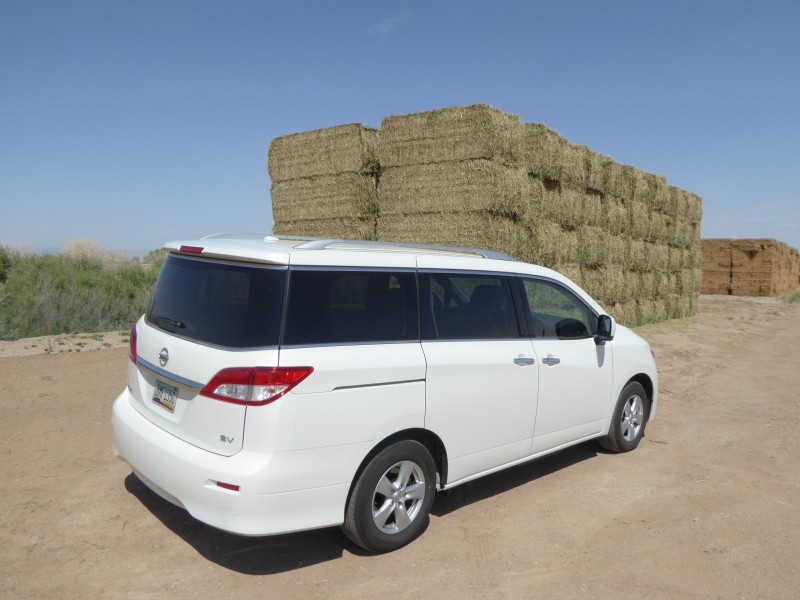



























The current Quest is the fourth to bear the name. The first two generations were produced as a joint venture with the Ford Motor Company, with the car branded as the Mercury Villager. The deal was dissolved as the two companies decided to head in separate directions early in the twenty-first century. Based on the Nissan Forum concept vehicle, the current Quest was launched at the 2011 Detroit Show, going on sale soon thereafter as a 2011 model. Unlike its predecessors, this one is built in Japan, though it is not actually sold there, Nissan preferring their Elgrand model to compete with the local rivals there, which is built on the same platform, but is 5″ narrower. It is based off Nissan’s D platform which also underpins the Altima and Maxima sedans and the Murano CUV. Although this is a big and bulky vehicle, at over 200″ long (16 foot 7″) and with a wheelbase over 118″, it is actually slightly smaller than its rather swoopily styled predecessor, despite what you might think when you look at the pair. The Quest has changed little since its introduction.
It probably makes sense to concentrate initially on the practical aspects of the Quest, as this will surely be the reason why you might be interested in one. Open the front door and look inside, and it does indeed appear huge. I joked that I could have cancelled my hotel reservation for the night, such is the amount of space in it. Unlike its competitors, most of which can accommodate 8, all Quests are 7 seaters. There are two seats up front, with a huge storage unit between them, which contains two of the many cupholders and a stowage recess on top, as well as containing a pull-out drawer in its lower part. There are also two seats in the middle row. These are like captain’s chairs, and there is a similar sort of stowage unit between these as well. These seats are on sliders, but even when set well forward, there is ample leg room, and thanks to the tall styling, masses of headroom. You can vary the angle of the backrest through quite an arc from almost vertical to almost 45 degrees to the horizontal. Armrests are on the side of each seat. The third row is more like a conventional bench. The backrests are asymmetrically split. The position of the seats is set, of course, and the backrest does not go up as far up your back as in the middle row. Getting in is not as hard as it is in some 3-row machines. The middle seats tip well forward out of the way and there is a decent sized gap to clamber through. Once installed, there is ample space for adults, though the seats are inevitably less comfortable than the middle row. There are stowage wells and cup holders moulded into the side panels. With all seats erect, there is still a reasonable amount of luggage room. It is not that long from front to back, my suitcase having to be put in side-on. But there is plenty of depth so you could pile things up. Unlike all its rivals, which have a deep well in their boots into which the third row fold backwards, in the Nissan the floor is flush with the bottom of the tailgate meaning that there is no well from which to extricate things. That does mean that there is slightly less space in the Quest’s boot than some of its rivals. If you want more room, then you just push the rear seat backrests forward and you get a much larger load platform which is completely flat. Apparently, the middle row of seats will fold down flat, but I did not figure out how to do this, despite pulling at all the various levers on the side of the seat. There was no handbook with the car to look up how to do it. The tailgate is huge and quite heavy. To help when you close it, there is electrical assistance in the SV trim that I experienced. The rear sliding doors are also powered by electric motors. There are switches on the dash so you can open them from the driver’s seat as well as by pulling the handle on the outside or inside of the door. Inside the cabin, practical touches abound. There are cup holders everywhere it seems with two which pop out from the lower dash as well as those between the seats. There also seemed to be recesses and storage drawers everywhere. There’s also a glovebox, bins on all four doors and there are map pockets on the back of the front seats. Good marks for practicality, then, which is the real raison d’etre of the Quest.
All that would be in vain, though, if the Nissan was no good to drive. You don’t expect sports car like qualities, of course, and you don’t get them, but unlike the last Sienna that I drove (the previous model, I admit), this one does have some saloon-car like attributes. Although it is a big vehicle, it is not intimidating to pilot. And it is all pretty conventional. All Quest models are powered by the same 3.5 litre V6 engine which generates 260bhp and driving the front wheels, as Quests are only available with two wheel drive. There is a CVT transmission, as you find in almost all US market Nissans these days. The engine does a good job. It even has quite a purposeful growl to it at some points in the rev range. It is smooth and refined and seemed well up to the challenge of giving the Quest appropriate levels of urge, though how potent it would see if the car were full laden with people and luggage I can be quite so sanguine about. One up, though, it was fine. Not nippy, for sure, as there is an awful lot of vehicle to get going, but the Quest was well able to keep up with the flow, and to nip out a lane to overtake on a busy freeway when the occasion called. At a steady cruise, the engine is quiet, and there is not much noise from the tyres or road, leaving just a rustle from the (very strong) wind by the A pillar. Thanks to the low noise levels and general feeling of composure, I found myself travelling at, cough, more than a few miles over the 75 mph speed limit, without even realising it. (I was not the only one!) Unlike the CVT in some of the smaller Nissans, this one seemed to work well, with no real difficulties for the transmission to catch up with the driver’s right foot, either when accelerating or when slowing down, so there was none of the jerkiness you can sometimes get with these gearbox types, and just a seamless acceleration when called for. I took the Nissan quite a long way from Phoenix, in quest (sorry!) of sunny skies on a blustery day when dense cloud was covering much of Arizona, which meant that the test distance was 353 miles. I put 15.42 gallons in it during the test, which computes to a respectable 22.89 mpg US or 27.3 mpg Imperial. I think credit for this result goes to the fact that almost all the test was done at a steady freeway cruising speed, with far less stop/start than is usually the case.
You don’t expect a sporty-feel to a vehicle like this, and you don’t get one, but nor is it anything like as devoid of sensation as the last Toyota Sienna that I drove. The steering is light, but not unduly so, so there is actually decent feel to the setup, yet the car is easy to manoeuvre. It rolls on corners, even at pretty moderate speeds, but there seems to be plentiful grip from the tyres, and the handling is predictably safe, with understeer evident even on those swooping curves that connect freeways together in the US. It was an extremely windy when I tested this Nissan, but despite seeing swirling dust clouds at the side of the road several times during the day, the Quest remained stable and seemingly impervious to what the forces of nature were up to. The Quest rides nicely, so it is clear that Nissan’s engineers have priorities comfort – quite correctly, given the target buyer’s likely requirements – over driving finesse, but have not gone too far away from the soggy or anaesthetised experience that others have done. The brakes proved up to scratch, though you do have to remember that this is a big heavy vehicle and it will need more space to stop than a conventional saloon car. There is a foot operated pedal parking brake. Visibility is generally good, with a lot of glass, though I did notice that there is a very thick C pillar, so at sharply angled junctions, there is quite an obscured area when you are looking sideways behind you over your shoulder. Reversing is fine, as there is a rear-view camera to assist, and despite the size of the Quest, it proved quite manoeuverable.
Nissan use a mixture of colours and materials to trim the inside of the Quest and I am not entirely persuaded that the result is a complete success, despite some US reviewers referring to it looking more like an Infiniti than a Nissan inside. The top of the dash moulding of the test car was black, with the lower half in a pale oatmeal colour to match the seat trim. Two very obviously very plastic inlays were used across the width of the outer parts of the dash for the fake wood and in the middle for the fake gunmetal. Worryingly, much of the oatmeal coloured items looked grubby already, even though the test car had covered under 4000 miles and was only a few weeks old, suggesting that a darker coloured trim may be a more practical choice. The glass area is big enough that it would not make it too gloomy. The dash moulding itself appears quite big, but that is because of the enlarged central section which houses the gear level, leaving a completely flat floor, with just that central stowage unit between the seats, but not connected to the dash. The instruments are typical Nissan. Three slightly overlapped circles, with a larger one in the centre for the speedo, rev counter on the left and the right hand one containing water temperature and fuel level stacked above each other. There are buttons flush on either side of the instrument nacelle, but finished in a grey colour so you can see them, which allow you to cycle through or rest the various trip computer readings. Twin column stalks operate lights and indicators from the left and wipers from the right. There are a lot of small buttons on the steering wheel boss, and these are for audio repeater functions and cruise control. In the centre of the dash, there is a traditional radio unit, mounted high up, with buttons and knobs to operate. It is quite a stretch from the driving seat, so you really do need the wheel-mounted repeaters. Beneath it is the set up for the climate control, arranged very much like the audio unit, with a small display screen surrounded by buttons and knobs to control. It sits to one side of the middle centre part of the dash, as the gearlever is alongside it. That’s more or less it. It is quite a simple and unfussy design, and to use a phrase that clearly eludes some manufacturers when they design their interiors, generally pretty “user friendly”.
The Nissan Quest comes in four different trims, ranging from the base Quest S to the swanky Quest Platinum. All of them are mechanically the same. The test car was a Quest SV, a midrange trim with a starting price just north of $30,000. This trim’s mix of minivan must-haves (like power-sliding doors, a rearview camera, and tri-zone climate control) and infotainment favourites (standard Bluetooth, a 5-inch infotainment display, and a USB port), along with a moderate $4,000 increase in sticker price makes the Quest SV a better bet than the base model. That entry level version is the Quest S and it comes with a 3.5-litre V6 engine, a continuously variable transmission (CVT), and front-wheel drive. The seating configuration consists of second-row captain’s chairs and a manually folding third-row bench seat with a 60/40 split. Standard features are slim; they include manually sliding doors, a proximity key, a four-speaker stereo, and a CD player. The Quest SV has a much more inviting assortment of standard features. Its infotainment system includes Bluetooth, a USB port, a 5-inch infotainment display, six speakers, satellite radio, and a rearview camera. Other niceties included in the SV trim – which has a starting price around $31,000 – are privacy glass, tri-zone automatic climate control, a leather-wrapped steering wheel, and power-sliding rear doors. Pricing increases to around $34,000 with the Quest SL. The extra money adds leather upholstery, heated front seats, an eight-way power-adjustable driver’s seat, heated mirrors, a power tailgate, and automatic on/off headlights. Nissan’s top-line Quest trim is the Platinum edition. Comfort amenities included with this model are memory settings for the driver, a power-folding bench seat in the third row, and sun shades in the second and third rows. Added technology includes navigation, voice recognition, a 13-speaker Bose sound system, and an 8-inch touch screen, along with safety features such as blind spot monitoring and an Around View monitor with moving object detection. The standard rear-seat entertainment system features an 11-inch screen, rear audio controls, two wireless headsets, and a remote control. Expect to pay around $43,000 for a Quest Platinum.
This sort of car is not really for me. I don’t have a family, and I very rarely carry one passenger let alone 6, so something this commodious is a long way from my requirements. That said, if I did, then the Quest could be worth considering. You will have to accept the looks, but let’s be honest, the rival products from Toyota, Honda, Kia and Chrysler are not exactly things of beauty, though the last two of these are rather better to behold than the first pair. I’ve not driven any of them in their latest guises, so it is hard to be sure which is “best”. The US press are pretty sure it’s not the Nissan, largely as they say that it lacks some of the latest safety features that probably stem from the fact that this is now the joint oldest design in the class (along with the Sienna, but that has been updated since its 2010 launch). Look past that, and the Quest has no real reasons to reject it. It is easy to drive, goes well, rides well, is quiet and comfortable, and there’s plenty of space for 7 people and their luggage. It is well trimmed. For a car of its genre, it largely hits the spot. The market does not really agree, though, with sales having plummeted in recent years, with the Nissan finding little favour compared to its rivals. Rumours suggest that 2017 could be the last year it is on sale, suggesting that the MiniVan sector will shrink still further.


















































